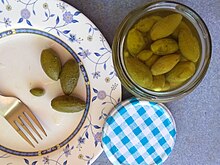Oroxylum indicum
| Oroxylum indicum | |
|---|---|

| |
| Plate from book Flora de Filipinas, Gran edicion, Atlas I. by Francisco Manuel Blanco , 1880-1883? where name is Bignonia quadripinnata, Blanco.
| |
| Scientific classification | |
| Kingdom: | Plantae |
| Clade: | Tracheophytes |
| Clade: | Angiosperms |
| Clade: | Eudicots |
| Clade: | Asterids |
| Order: | Lamiales |
| Family: | Bignoniaceae |
| Tribe: | Oroxyleae |
| Genus: | Oroxylum Vent. |
| Species: | O. indicum
|
| Binomial name | |
| Oroxylum indicum | |
| Synonyms[2] | |
|
List
| |
Oroxylum indicum is a species of
Taxonomy
Its genus name Oroxylum comes from Greek words ὄρος oros 'mountain' and ξύλον xylon 'wood', its epithet means "from India".[11]
Description
The tree grows up to 27 m (89 ft) tall with a trunk diameter of 10–40 cm (3.9–15.7 in) with gray bark. A mature tree has few branches
The flowers grow from long pedicels at the end of 2-4 cm long
-
Fruit
-
Large Oroxylum pods sold at a market in Bangkok, Thailand
Distribution
Oroxylum indicum is native to the
It is visible in the forest biome of
and also in Mizoram.Ecology
Oroxylum indicum lives in relationship with the actinomycete Pseudonocardia oroxyli present in the soil surrounding the roots.[17] Septobasidium bogoriense is a fungal species responsible for velvet blight in O. indicum.[citation needed]
Phytochemistry
Various segments of O. indicum, including leaves, root bark,
Uses
The tree is often grown as an ornamental plant for its strange appearance. Materials used include the wood, tannins and dyestuffs.[19]
In marriage rituals
The plant is used by the
In the Himalayas, people hang sculptures or garlands made from O. indicum (Skr. shyonaka) seeds from the roof of their homes in belief they provide protection.[20]
As food

It is a
The plant is used as food by the Karen people. The flower buds are boiled and pickled. The young pods are cut open raw and the tender seeds inside, having the color and texture of lettuce leaves, are used in various local dishes.[22]
In traditional medicine
Oroxylum indicum seeds are used in traditional Indian Ayurvedic and Chinese medicines.[9] Root bark is one of the ingredients thought to be useful in compound formulations in Ayurveda and other folk remedies.[9][23][24]
In art
In mythology
Because the pods are shaped like swords, people in West Java believe planting oroxylum trees can protect their homes from thieves.[3]: 130
The Onge name for the tree is talaralu.[26] According to an Onge myth, the first of the Onge people, also named Onge, was created by Eyuge (monitor lizard) from oroxylum wood. Onge made a shelter and planted oroxylum trees around it, and created more human beings from the trees. The trees were planted in pairs, giving rise to both Onge men and women. Only Onge people were created in this way; Onge mythology offers no explanation for the existence of non-indigenous people or other indigenous Andamanese peoples.[27]
Gallery
-
Flowers
-
Leaves
See also
References
- ^ "The International Plant Names Index".
- ^ a b "Oroxylum indicum (L.) Benth". The World Flora Online. World Flora Consortium. 2024. Retrieved 17 April 2024.
- ^ a b c d e van Steenis, C.G.G.J. (1974). "Bignoniaceae". Flora Malesiana. 8 (1): 114–186 – via Naturalis Institutional Repository.
- ^ A Review on the Taxonomy, Ethnobotany, Chemistry and Pharmacology of Oroxylum indicum Vent
- ^ "Oroxylum indicum". Germplasm Resources Information Network. Agricultural Research Service, United States Department of Agriculture. Retrieved 15 December 2017.
- ^ "Ecoport".
- ^ a b c d "Broken bones tree". Flowers of India. Retrieved 11 December 2017.
- ^ efloraofindia - Oroxylum indicum
- ^ PMID 22923859.
- ^ India Biodiversity Portal - Oroxylum indicum (L.) Kurz
- ISBN 9781108640633.
- ^ a b Corner, E. J. H. (1952). Wayside Trees of Malaya. Vol. 1. Singapore: Govt. Printing Office. p. 166.
- ^ a b Phillipps, Anthea (22 April 2012). "The Midnight Horror Tree". Daily Express. Retrieved 5 September 2012.
- ^ Barwick M, van der Schans A (2004). Tropical and Subtropical Trees - An Encyclopedia. Portland: Timber Press. p. 304.
- ^ "Oroxylum indicum". eFloras.org. Dinghushan Plant Checklist, Chinese Academy of Science.
- ^ Theobald, W.L. (1981). Bignoniace. In: Dassanayake, M.D. and Fosberg, F.R. (Eds.). A Revised Handbook to the Flora of Ceylon. Amerind Publishing Co. Pvt. Ltd., New Delhi.
- PMID 16957120.
- .
- PMID 28356115.
- ISBN 9747315432.
- ^ Thai Dishes, Central Part And South Archived March 30, 2012, at the Wayback Machine
- PMID 32498413.
- PMID 23326090.
- ^ Jayaweera, D.M.A. (1981). Medicinal Plants (Indigenous and Exotic) Used in Ceylon. Part I (Acanthaceae – Burseraceae). National Science Council of Sri Lanka, Colombo.
- ISBN 9789832457336.
- S2CID 39096375– via JSTOR.
- ISBN 9788791563041.





